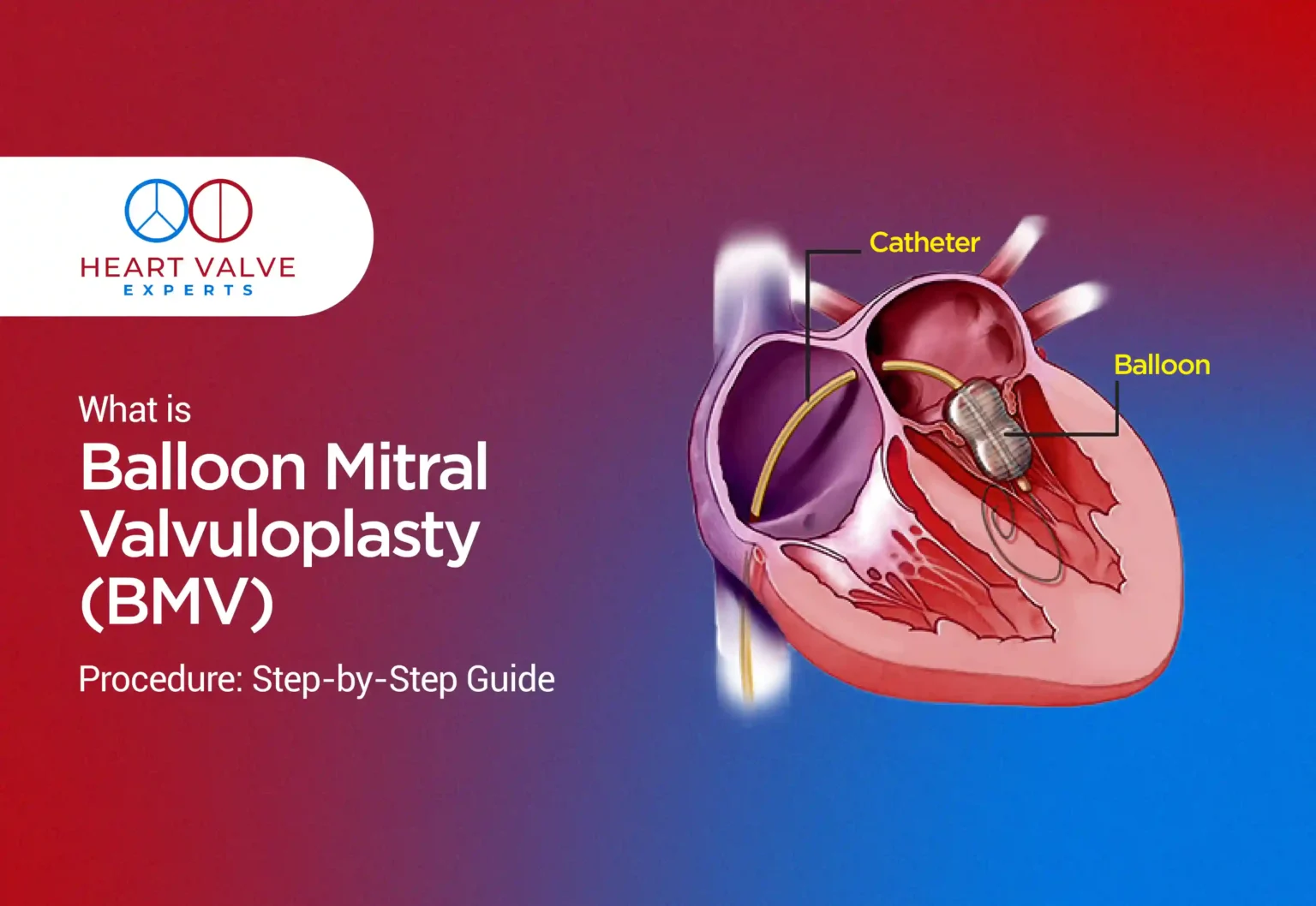Millions of people worldwide suffer from heart valve diseases, and one of the most prevalent ailments that call for specialised care is mitral valve stenosis. In India alone, rheumatic heart disease, which is a major cause of mitral stenosis, affects an estimated 2.5 to 3 million people. Many of these cases remain undiagnosed until complications arise. Among the various therapeutic options, the full form of BMV, balloon mitral valvuloplasty procedure has been a game-changer due to its significant influence on patients’ lives as well as its clinical efficacy. First performed in 1984, this minimally invasive procedure has helped many individuals, particularly younger patients in areas where rheumatic heart disease is still widespread, avoid open-heart surgery and restore normal heart function. Everything you need to know about the BMV procedure, from the initial evaluation to long-term rehabilitation, will be covered in this blog.
What is Balloon Mitral Valvuloplasty?
Balloon Mitral Valvuloplasty (BMV) is a minimally invasive cardiac procedure designed to treat mitral valve stenosis, a condition where the mitral valve becomes narrowed and restricts blood flow from the left atrium to the left ventricle. The balloon valvuloplasty procedure involves threading a special balloon catheter through blood vessels to reach the narrowed valve, then inflating the balloon to stretch and open the valve leaflets.
This BMV in medical cardiology technique has become the gold standard for treating suitable candidates with mitral stenosis, offering excellent outcomes with reduced surgical risks compared to traditional open-heart procedures. The procedure effectively increases the valve area, allowing improved blood flow and reducing symptoms associated with mitral valve stenosis.
Who Needs the BMV Procedure?
The balloon mitral valvotomy procedure is recommended for patients with symptomatic mitral valve stenosis who meet specific criteria. Ideal candidates typically have:
- Moderate to severe mitral stenosis with a valve area less than 1.5 cm²
- Symptomatic patients experiencing shortness of breath, fatigue, or chest pain
- Suitable valve anatomy with minimal calcification
- No major leakage in the mitral valve
- No blood clot in the left
Conservative Treatment Alternatives
Before considering the BMV procedure, patients may initially be managed with conservative treatments, including:
- Medications to control heart rate and rhythm
- Anticoagulants to prevent blood clots
- Diuretics to manage fluid retention
- Activity modification and lifestyle changes
When BMV Becomes Necessary?
The bottom line for needing this intervention is when conservative treatments fail to adequately manage symptoms, or when the stenosis progresses to a point where it significantly impacts quality of life and cardiac function. Without intervention, severe mitral stenosis can lead to heart failure, atrial fibrillation, and other serious complications.
Step-by-Step BMV Procedure
The balloon mitral valvotomy procedure follows a systematic approach:
Step 1: Anesthesia and Access
The procedure begins with local anesthesia and conscious sedation. The interventional cardiologist gains access through the femoral vein in the groin area.
Step 2: Transseptal Puncture
A crucial step in the BMV procedure steps involves creating a small opening in the atrial septum (which separates the right and left atria) to access the left atrium, where the mitral valve is located.
Step 3: Catheter Placement
Specialized catheters are carefully guided through the blood vessels and positioned across the mitral valve under fluoroscopic guidance.
Step 4: Balloon Positioning and Inflation
The balloon catheter is positioned across the stenotic mitral valve, and the balloon is inflated to stretch the valve leaflets and increase the valve opening.
Step 5: Assessment and Completion
The cardiologist assesses the results using echocardiography and pressure measurements. If satisfactory, the catheters are removed, and the access site is closed.
Potential Benefits and Risks of BMV
Understanding the potential benefits and risks of BMV is essential before proceeding with the procedure. While BMV offers significant advantages for suitable candidates, it’s important to be aware of the associated risks to make an informed decision.
Benefits of the BMV Procedure
The balloon mitral valvuloplasty procedure offers numerous advantages:
- Minimally invasive approach with faster recovery
- Significant improvement in symptoms and exercise tolerance
- Excellent long-term outcomes in suitable candidates
- Lower procedural risks compared to surgical heart valve replacement
- Preservation of the patient’s natural valve
- Shorter hospital stay and reduced cost
Potential Risks and Complications
Like any medical procedure, the BMV procedure carries certain risks:
- Mitral regurgitation (valve leakage)
- Cardiac tamponade or pericardial effusion
- Systemic embolism
- Arrhythmias
- Vascular complications at the catheter insertion site
- Rare risk of emergency surgery
The overall complication rate is low, with most patients experiencing significant improvement in their condition.
Patient Preparation for BMV
Proper preparation is crucial for successful the BMV procedure steps. The preparation process includes:
Pre-procedure Assessment
- Comprehensive cardiac evaluation including echocardiography
- Transesophageal echocardiogram (TEE) to assess valve anatomy
- Cardiac catheterization, if needed
- Blood tests, including coagulation studies
- Chest X-ray and ECG
Pre-operative Instructions
- Fasting for 8-12 hours before the procedure
- Medication adjustments as advised by the cardiologist
- Anticoagulation management
- Arrangement for post-procedure care and transportation
In-Hospital Recovery
Following the balloon valvuloplasty procedure, patients typically experience:
Immediate Post-Procedure Care
- Monitoring in the cardiac catheterization laboratory recovery area
- Frequent vital sign checks and cardiac rhythm monitoring
- Echocardiogram to assess valve function
- Bed rest for 4-6 hours to allow the access site to heal
Hospital Stay
Most patients undergoing BMV in cardiology can expect:
- Hospital stay of 1-2 days for uncomplicated cases
- Gradual mobilization and activity progression
- Medication adjustments as needed
- Discharge planning and follow-up arrangements
Long-term Recovery and Follow-up
A structured recovery plan and regular follow-up are key to ensuring the long-term success of balloon mitral valvuloplasty. While most patients recover quickly, ongoing monitoring helps detect and manage any late complications.
Recovery Timeline
The recovery from the balloon mitral valvuloplasty procedure is generally swift:
- Most patients can return to normal activities within a week
- Full recovery typically occurs within 2-4 weeks
- Significant symptom improvement is often noticed immediately
Long-term Complications and Monitoring
While the BMV procedure has excellent long-term outcomes, patients require ongoing monitoring for:
- Restenosis (re-narrowing of the valve)
- Development of mitral regurgitation
- Atrial fibrillation (heart rhythm disorder)
- Progression of underlying heart valve disease
Regular follow-up appointments with echocardiography are essential to monitor valve function and detect any complications early.
Conclusion
The balloon mitral valvotomy procedure represents a significant advancement in treating mitral valve stenosis, offering patients an effective, minimally invasive option with excellent outcomes. With proper patient selection, careful preparation, and skilled execution of the BMV procedure steps, patients can expect significant improvement in their symptoms and quality of life.
For patients considering this procedure, it’s essential to consult with experienced cardiac specialists who can provide personalized assessment and treatment recommendations based on individual circumstances.
If you or a loved one is experiencing symptoms of heart valve disease, don’t wait for the condition to worsen. Contact our Heart Valve Expert Clinic today to schedule a comprehensive evaluation. Our team of experienced cardiologists specializes in advanced treatments, including the BMV Procedure in Mumbai, ensuring you receive the highest quality care for your heart valve condition.
FAQs
The BMV procedure typically takes 1-2 hours, depending on the complexity of the case and patient anatomy.
Most patients can return to normal activities within a week, with full recovery occurring within 2-4 weeks.
Balloon Mitral Valvuloplasty (BMV) has high immediate success rates, with around 90–94% of patients experiencing significant symptom relief and improved valve function.
Yes, balloon valvotomy and valvuloplasty refer to the same procedure. Both terms describe the technique of using a balloon to open a narrowed heart valve.
BMV stands for Balloon Mitral Valvuloplasty is a minimally invasive cardiac procedure designed to treat mitral valve stenosis, a condition where the mitral valve becomes narrowed.
Read more blogs:

